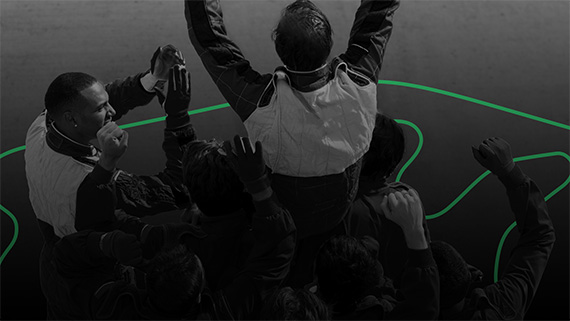Words have amazing power and used in a proper way can become the most vital part of all of the marketing activities. Creating amazing stories, catchy phrases, and tailor-made slogans require quite a set of skills. And have you ever thought about the differences that working in different languages brings? Check our conversation with Marta Pelska, Senior Copywriter at Performante who talks about looking for inspirations, nourishing a creative mind, and things that make her cringe, in the most riveting way.

Marta Pelska, Copywriter
So, what’s that fuss all about? What do you actually do?
I am a copywriter. Or, given my experience, copy-all writer. It’s started when I was a student and frankly, I don’t know any other way. Or maybe it’s just an excuse not to grow up entirely? Anyways, my life up to date has been all about writing, scribbling, making up stories, occasionally rhyming, and playing on words. And I hope I’ll keep it that way.
I suspect that it is impossible to be creative 24/7. Where do you take inspiration from? Do you have any tricks?
No, why? :) But to be honest, it’s very hard to leave your work, when your work somehow lives inside you, as it’s mostly brain thing… There’re many ways to exercise a “creative bone” and for each person, something different will come in handy, but these are the most obvious:
-
Be en vogue with everything that’s happening in the ad world — trends, tendencies, and newest campaigns.
-
Feed your mind both with “good” movies and movie junk (worked well for Quentin Tarantino, didn’t it?).
-
Observe what’s going on in the area of your mother tongue; for example, by following the annual contest for the most popular Polish word among youngsters, by reading a lot of forums and comments in SoMe, etc.
-
Listen to people. Who knows, maybe in someone’s funny remark about something or family anecdote randomly passed at lunch you’ll find a spark for your future copy?
-
Exceed writing abilities constantly… writing. Do not narrow your specialization to copywriting only, because soon you’ll feel like a hamster in a cage. Try different forms and styles. Try to rhyme. Write a song. And please, please, please, have fun with that.
Trends are present in every area of our lives and marketing bases on them as well. Do you believe that right now there are any prominent trends when it comes to copywriting, creating content, and playing with words?
I think there are at least two layers of trends in copywriting right now. First concerns the profession itself, the other is about the writing techniques. As for the first, we can observe that there is a strong need for copywriting specialization. Before, there was just an ATL copywriter and BTL copywriter; now agencies are looking for SEO specialists, “social media ninjas”, “content kings” — generally people, who not only “write” digital, but also “think” digital. With the pandemic, there will be an increasing demand for digital copywriters in e-commerce, as shopping may become a thoroughly virtual experience.
As for the second layer, there’s a claim for a popular beer, that uses, among other words, the first syllable of the product’s name (Chce się Ży- piwo Żywiec). It was cool and creative when it came out, and opened many interesting meanings and ways to play with the content. But then, many followed this pattern: a popular newspaper, brand for mineral water, other beer… and making a copy of the copy is what a surprise, just a lazy approach. Another tendency is getting back to good ole’ play on words, we’ve observed it with my workmates in many latest EB campaigns and I am not sure I liked it. I mean, when a beauty store released a series of layouts, they were witty and neat, but when the others followed, again, felt a bit forced and plain. Just to be clear, I have nothing against play on words, I am rooting for a campaign of a job portal, using names of cities and streets to create sentences with funny (yet real) reasons why one should look for a new job. The idea was laying on the street, so to speak. But again, if there’s just a play on words without any backbone of insights and observations, it is just a fleeting pleasure soon to be forgotten.
How copywriting changed over the years? Do you believe that right now we are “more digital” also in that aspect?
Hmm… it’s hard to grasp almost two decades of copywriting briefly, but I think that if language changes, so does copywriting. Those changes are especially palpable in the content copywriting, which is the closest to the “living”, informal speech. But I enjoy it, as there are more neologisms, bold and creative use of language, sometimes on the border of the norm and a good taste, as sometimes said neologisms are mimicking profane language — hence “mentolnięcie” and “zapachnisty”, but… It’s good, it means the language evolves. What else? I really enjoy the presence of the RTM phenomenon in social media, it’s like a social barometer and proof that brands can at least try to get closer to the consumer’s heartbeat. And yes, I do believe, that laughing not only saves our lives but also… sells.
You are working in three languages — Polish, English and Spanish — is working in another language different than in your native? Is it challenging or maybe it gives a perspective that comes in handy? Can you point out what do you especially like about each language? Is there one that you especially like to work with?
I wouldn’t go so far to say that I am working with Spanish, I’m more in the process of dusting off this language, as I left it hanging almost 10 years ago.
But getting back to the question — each language has both its beauty and its harsh side. For me, Polish is really hard in terms of creating puns, but at the same time, great for epic story-telling, big body copies… and dialogues. English, on the other hand, is more synthetic, you can say more with fewer words and it’s made for generating puns and quick come-backs. Spanish is tricky — seems to be very easy, but when you start digging, you see it’s easy indeed, but to make a fool of yourself:) But hey, it’s totally forgiven, while its melody and rhythm are unique and beautiful. Of course, I am no language expert, that’s just how I feel, facing tasks in different languages.
Now let’s talk future for a bit — do you think that nowadays the brands and companies should turn to more global ways of communicating — using standardized slogans for every market and sticking only to English which obviously becomes the language of the digital era, or do you believe that there is still power in the regional touch?
Let’s be real, English is already everywhere. Global brands use their claims in different countries, English vocabulary is “penetrating” local copies and claims. It’s not a sudden trend, it’s an increasing tendency. I think that there will always be an inclination to English, because of social media platforms, and because, well, “Think different” sounds better than “Myśl inaczej”. Personally, I’m all for having fun with languages — mashing them up and finding new meanings. It’s like alchemy, you know? I believe that each language is a fluid material we can mold and explore its new possibilities. It was applied more than once in literature, for example in “Clockwork orange”, so why not apply it in advertising?
Can you point out some good practices?
There’s so much commercial clutter these days, that it’s easy to overlook a real gem. But what I really liked and what got imprinted to my memory, even though it was last year, was a social media campaign for Polish vodka. It played with the idea of “socializing” in the more traditional sense. The whole campaign was called “social table” (“stół społecznościowy”) and mocked social media a bit, comparing face to face meetings with virtual ones, but did it with gusto and rare kind of wit. I really marveled at how ballsy that was to mock the actual platform they were using, and how they were able to omit all the legal problems with advertising alcohol. Maybe because vodka served more as a background for the idea? Anyway, judging by the reactions, the reception of the campaign was rather enthusiastic.
And what makes you cringe?
Oooh, you’ve opened a Pandora Box with this one, there’s a lot of stuff. But first, let me diversify because there’s a good cringe (a cringe which is deliberately used, hence Budwiser’s “Real men of genius” series of ads that makes you laugh despite cringe-y men depicted there) and a bad cringe. The latter, to name the few: shamelessly sexist adverts (yep, no matter how “woke” we are, they’re still there and going strong), brands brainlessly using youth slang to sound cool (while they don’t), claims that rhyme, taking a popular song and replacing original lyrics with CTAs, absolutely ALL radio ads for medical products and health supplements. Also, as a mother of a 4-year kid, I hate all the ads that try to convince me about chocolate cream packed with palm oil and glucose syrup being a wholesome meal and a good start of a day. I mean, have you ever seen a kid with a sugar rush, people? Run for your life! I’d respect those brands much more if they went with brutal honesty and real parental insights. Imagine calling the popular milk sandwich “the ultimate bribe you can give to your children to make them eat the broccoli”. That would be something!





